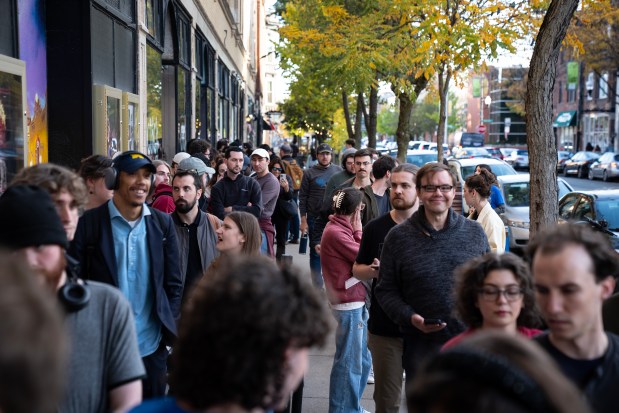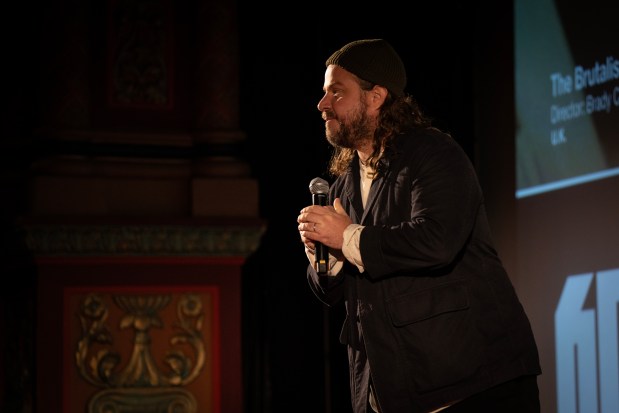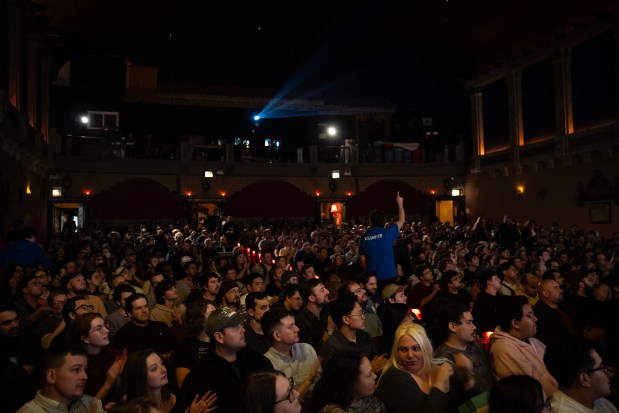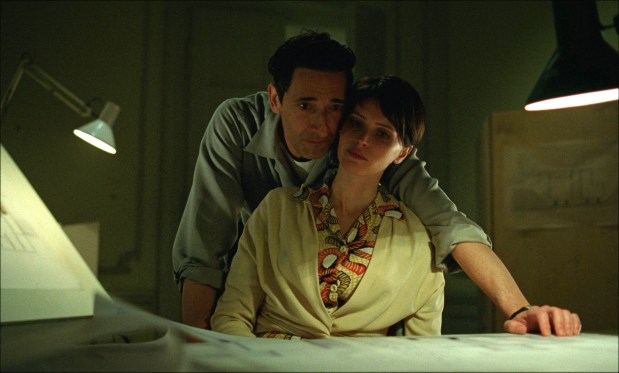One night last month, near the end of the Chicago International Film Festival, a particularly long line of moviegoers snaked down Southport Avenue by the Music Box Theatre. The hot ticket? This fall’s hottest ticket, in fact, all over the international festival circuit?
Well, it’s a 215-minute drama about a fictional Hungarian Jewish architect who emigrates to America in 1947 after surviving the Holocaust. The film’s title, “The Brutalist,” references several things, firstly a post-World War II design imperative made of stern concrete, steel, and a collision of poetry and functionality.
Director and co-writer Brady Corbet, who wrote “The Brutalist” with his filmmaker wife, Mona Fastvold, explores brutalism in other forms as well, including love, envy, capitalist economics and how the promise of America eludes someone like the visionary architect László Tóth, played by Adrien Brody. Corbet, now 36 and a good bet for Oscar nominations this coming January, says his unfashionable sprawl of a picture, being distributed by A24, is also about the “strange relationship between artist and patron, and art and commerce.”
It co-stars Felicity Jones as the visionary architect’s wife, Erzsébet, trapped in Eastern Europe after the war with their niece for an agonizingly long time. Guy Pearce portrays the imperious Philadelphia blueblood who hires Tóth, a near-invisible figure in his adopted country, to design a monumental public building known as the Institute in rural Pennsylvania. The project becomes an obsession, then a breaking point and then something else.
Corbet’s project, which took the better part of a decade to come together after falling apart more than once, felt like that, too.
Spanning five decades and filmed in Hungary and Italy, “The Brutalist” looks like a well-spent $50 million project. In actuality, it was made for a mere $10 million, with Corbet and cinematographer Lol Crawley shooting on film, largely in the VistaVision process.
The filmmaker said at the Chicago festival screening: “Who woulda thunk that for screening after screening over the last couple of months, people stood in line around the block to get into a three-and-a-half-hour movie about a mid-century designer?”
He lives in Brooklyn, New York, with Fastvold and their daughter. Our conversation has been edited for clarity and length.
Q: Putting together an independent movie, keeping it on track, getting it made: not easy, as you told the Music Box audience last night. Money is inevitably going to be part of the story of “The Brutalist,” since you had only so much to make a far-flung historical epic.
A: Yeah, that’s right. In relation to my earlier features, “The Childhood of a Leader” had a $3 million budget. The budget for “Vox Lux” was right around $10 million, same as “The Brutalist,” although the actual production budget for “Vox Lux” was about $4.5 million. Which is to say: All the money on top of that was going to all the wrong places.
For a lot of reasons, when my wife and I finished the screenplay for “The Brutalist,” we ruled out scouting locations in Philadelphia or anywhere in the northeastern United States. We needed to (film) somewhere with a lot less red tape. My wife’s previous film, “The World to Come,” she made in Romania; we shot “Childhood of a Leader” in Hungary. For “The Brutalist” we initially landed on Poland, but this was early on in COVID and Poland shut its borders the week our crew was arriving for pre-production. When we finally got things up and running again with a different iteration of the cast (the original ensemble was to star Joel Edgerton, Marion Cotillard and Mark Rylance), after nine months, the movie fell apart again because Russia’s invasion of Ukraine. We couldn’t get any of the banks to cash-flow the tax credit (for location shooting in Poland). It’s completely stable now, but at that time the banks were nervous about whether the war would be contained to Ukraine or not.
And then we finally got it up and running in Budapest, Hungary.
Q: That’s a long time.
A: Every filmmaker I know suffers from some form of post-traumatic stress (laughs). It sounds funny but it’s true. At every level. On the level of independent cinema, you’re just so damn poor. You’re not making any money, and yet from nose to tail, at minimum, a movie always takes a couple of years. With bigger projects, you might have a little more personal security but a lot less creative security with so many more cooks in the kitchen. Either route you choose, it can be an arduous and painful one.


Whether you’re making a movie for a million dollars, or $10 million, or $100 million, it’s still “millions of dollars.” And if you’re concerned about the lives and livelihoods of the people working with you, it’s especially stressful. People are constantly calling you: “Is it happening? Are we starting? Should I take this other job or not?” And you have 250 people who need that answer from you. Every iteration of the project, I always thought we were really about to start in a week, two weeks. It’s just very challenging interpersonally. It’s an imposition for everyone in your life. And then there’s the imposition of screening a movie that’s three-and-a-half-hours long for film festivals, where it’s difficult to find that kind of real estate on the schedule. So essentially, making a movie means constantly apologizing.
Q: At what point in your acting career did you take a strong interest in what was going on behind the camera?
A: I was making short films when I was 11, 12 years old. The first thing I ever made more properly, I guess, was a short film I made when I was 18, “Protect You + Me,” shot by (cinematographer) Darius Khondji. It was supposed to be part of a triptych of films, and I went to Paris for the two films that followed it. And then all the financing fell through. But that first one screened at the London film festival, and won a prize at Sundance, and I was making music videos and other stuff by then.
Q: You’ve written a lot of screenplays with your wife. How many?
A: Probably 25. We work a lot for other people, too. I think we’ve done six together for our own projects. Sometimes I’ll start something at night and my wife will finish in the morning. Sometimes we work very closely together, talking and typing together. It’s always different. Right now I’m writing a lot on the road, and my wife is editing her film, which is a musical we wrote, “Ann Lee,” about the founder of the Shakers.
I’m working on my next movie now, which spans a lot of time, like “The Brutalist,” with a lot of locations. And I need to make sure we can do it for not a lot of money, because it’s just not possible to have a lot of money and total autonomy. For me making a movie is like cooking. If everyone starts coming in and throwing a dash of this or that in the pot, it won’t work out.

A continuity of vision is what I look for when I read a novel. Same with watching a film. A lot of stuff out there today, appropriately referred to as “content,” has more in common with a pair of Nikes than it does with narrative cinema.
Q: Yeah, I can’t imagine a lot of Hollywood executives who’d sign off on “The Brutalist.”
A: Well, even with our terrific producing team, I mean, everyone was up for a three-hour movie but we were sort of pushing it with three-and-a-half (laughs). I figured, worst-case scenario, it opens on a streamer. Not what I had in mind, but people watch stuff that’s eight, 12 hours long all the time. They get a cold, they watch four seasons of “Succession.” (A24 is releasing the film in theaters, gradually.)
It was important for all of us to try to capture an entire century’s worth of thinking about design with “The Brutalist.” For me, making something means expressing a feeling I have about our history. I’ve described my films as poetic films about politics, that go to places politics alone cannot reach. It’s one thing to say something like “history repeats itself.” It’s another thing to make people see that, and feel it. I really want viewers to engage with the past, and the trauma of that history can be uncomfortable, or dusty, or dry. But if you can make it something vital, and tangible, the way great professors can do for their students, that’s my definition of success.
“The Brutalist” opens in New York and Los Angeles on Dec. 20. The Chicago release is Jan. 10, 2025.
Michael Phillips is a Tribune critic.





